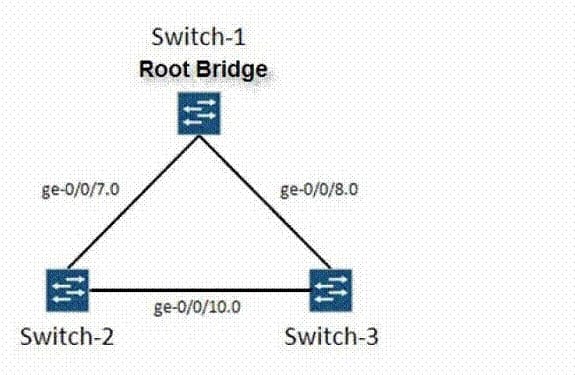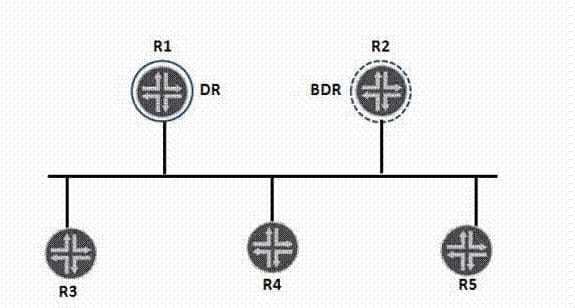Exam Details
Exam Code
:JN0-343Exam Name
:Juniper Networks Certified Internet Specialist (JNCIS-ENT)Certification
:Juniper CertificationsVendor
:JuniperTotal Questions
:563 Q&AsLast Updated
:Jun 12, 2025
Juniper Juniper Certifications JN0-343 Questions & Answers
-
Question 431:

As shown in the exhibit, three switches are connected and participating in RSTP. Switch
-1 was elected the root bridge and Switch-2 has a lower-cost path to the root bridge than Switch-3. Based on the details provided, which three statements are correct? (Choose three.)
A. Switch-3's ge-0/0/10.0 port assumes the alternate role and blocking state.
B. Switch-3's ge-0/0/10.0 port assumes the designated role and forwarding state.
C. Switch-2's ge-0/0/10.0 port assumes the designated role and forwarding state.
D. Switch-1's ports all assume the root port role and the forwarding state.
E. Switch-1's ports all assume the designated port role and the forwarding state.
-
Question 432:
Why would you configure root protection?
A. You want to protect the root bridge from receiving BPDUs on unauthorized interfaces.
B. You want to protect your network from unwanted topology changes from a rogue switch attempting to become the root bridge.
C. You want to avoid a broadcast storm that originates on the root bridge.
D. You want to prevent unwanted user authentication to the root bridge by defining an acceptable source-address list for authorized access.
-
Question 433:
Which mechanism keeps a switch from forwarding Layer 2 traffic from one broadcast domain to another?
A. filtering
B. BPDU guard
C. aging
D. learning
-
Question 434:
Which two statements accurately describe the factory-default storm control configuration? (Choose two.)
A. Storm control monitors traffic levels for broadcast traffic.
B. Storm control monitors traffic levels for multicast traffic.
C. Storm control drops all monitored traffic in excess of 80 percent.
D. Storm control drops all monitored traffic in excess of 20 percent.
-
Question 435:
No user-defined configuration exists for the default VLAN. Which configuration is valid on EX Series switches?
A. {master:0}[edit interfaces ge-0/0/4] user@ex# show unit 0 { family ethernet-switching { port-mode trunk; vlan { members [ v4 v3 ]; } native-vlan-id default; } }
B. {master:0}[edit interfaces ge-0/0/4] user@ex# show unit 0 { family ethernet-switching { port-mode trunk; vlan { members [ v4 default ]; } } }
C. {master:0}[edit interfaces ge-0/0/4] user@ex# show unit 0 { family ethernet-switching { port-mode access; vlan { members [ v4 default ]; } } }
D. {master:0}[edit interfaces ge-0/0/4] user@ex# show unit 0 { family ethernet-switching { port-mode access; vlan { members [ v4 Voice ];
}
}
}
-
Question 436:
You just implemented RSTP in your Layer 2 network. Which two statements are true? (Choose two.)
A. Switch ports in the alternate port role operating in indirect-recovery mode can immediately transition to the root port role and forwarding state when a failure occurs without waiting for the timer to expire.
B. Switch ports in the alternate port role operating in shared mode can immediately transition to the root port role and forwarding state when a failure occurs without waiting for the timer to expire.
C. Switch ports in the alternate port role operating in point-to-point mode can immediately transition to the root port role and forwarding state when a failure occurs without waiting for the timer to expire.
D. Switch ports operating as edge ports automatically transition to the forwarding state, even directly after a failure and recovery scenario.
-
Question 437:
Which two statements are true regarding BPDUs of spanning tree protocols? (Choose two.)
A. Configuration BPDUs function as keepalives in STP and RSTP.
B. BPDUs are sent by the designated bridge but not the backup bridge on shared segments.
C. Configuration BPDUs are sent by both switches on point-to-point connections.
D. Configuration BPDUs are not sent out interfaces configured as edge ports.
-
Question 438:
Which function(s) does STP serve in a Layer 2 network?
A. It detects and stops broadcast storms.
B. It distributes VLAN information between switches when a VLAN spans more than one switch.
C. It detects and eliminates loops.
D. It manages aggregated Ethernet bundles that span more than one switch.
-
Question 439:
At which configuration hierarchy level is a static bridge table entry configured?
A. [ interfaces interface-name ]
B. [ protocols ]
C. [ ethernet-switching-options ]
D. [ forwarding-options ]
-
Question 440:

In the exhibit, you run the command show ospf neighbor on R3 and notice that an adjacency with R5 remains in the 2-Way state. Which statement is true?
A. A problem exists with the physical link or Data Link Layer connectivity.
B. The area type does not match on each end of the link.
C. The IP MTU does not match on each end of the link.
D. This output is normal in this configuration.
Related Exams:
JN0-102
Internet Associate, Junos(JNCIA-Junos)JN0-104
Junos, Associate (JNCIA-Junos)JN0-105
Junos, Associate (JNCIA-Junos)JN0-1101
Juniper Networks Certified Design Associate (JNCDA)JN0-1103
Design, Associate (JNCIA-Design)JN0-130
Juniper networks Certified internet specialist.e(jncis-e)JN0-1301
Data Center Design, Specialist (JNCDS-DC)JN0-1302
Data Center Design Specialist (JNCDS-DC)JN0-1331
Security Design, Specialist (JNCDS-SEC)JN0-1332
Security Design, Specialist (JNCDS-SEC)
Tips on How to Prepare for the Exams
Nowadays, the certification exams become more and more important and required by more and more enterprises when applying for a job. But how to prepare for the exam effectively? How to prepare for the exam in a short time with less efforts? How to get a ideal result and how to find the most reliable resources? Here on Vcedump.com, you will find all the answers. Vcedump.com provide not only Juniper exam questions, answers and explanations but also complete assistance on your exam preparation and certification application. If you are confused on your JN0-343 exam preparations and Juniper certification application, do not hesitate to visit our Vcedump.com to find your solutions here.